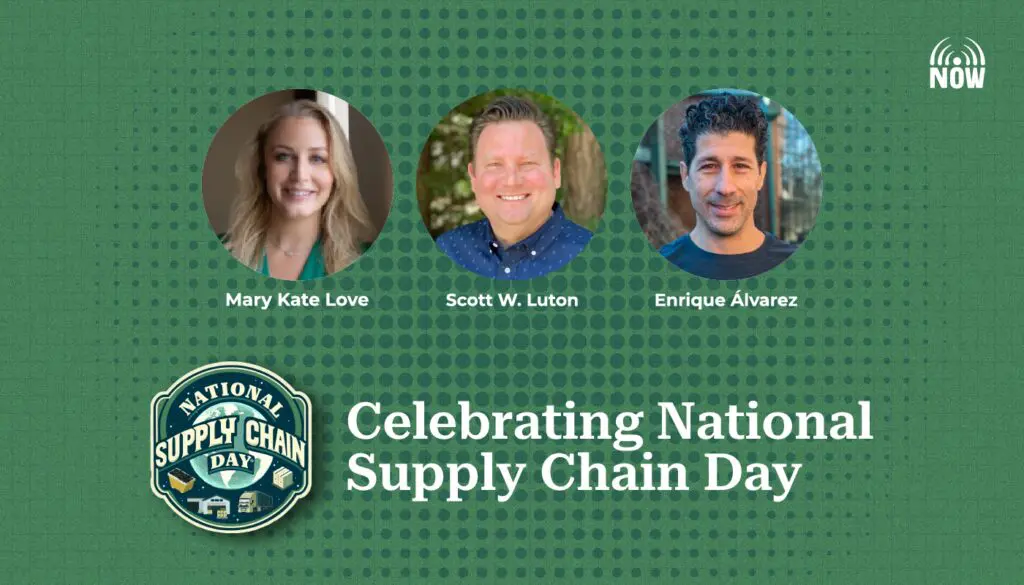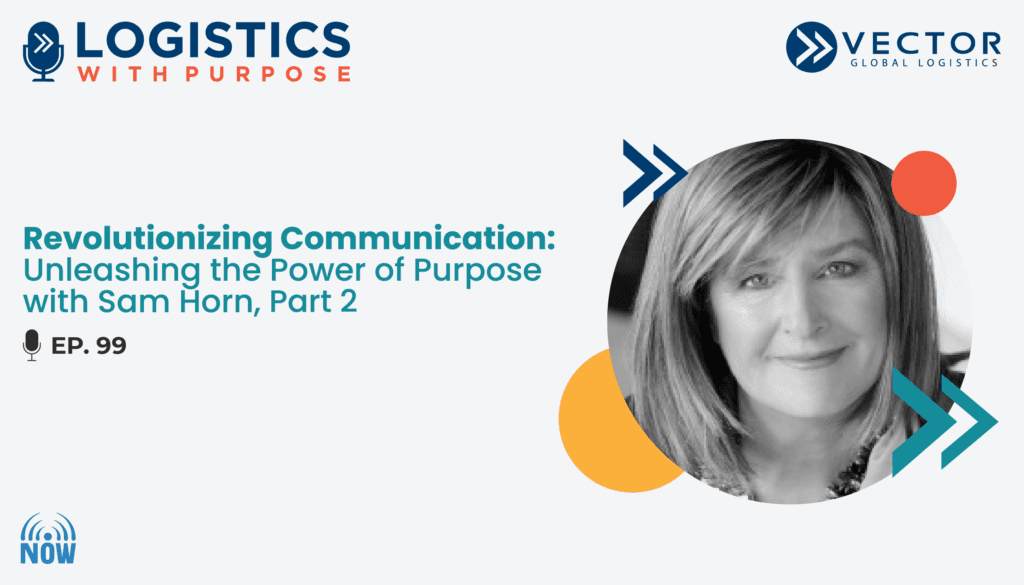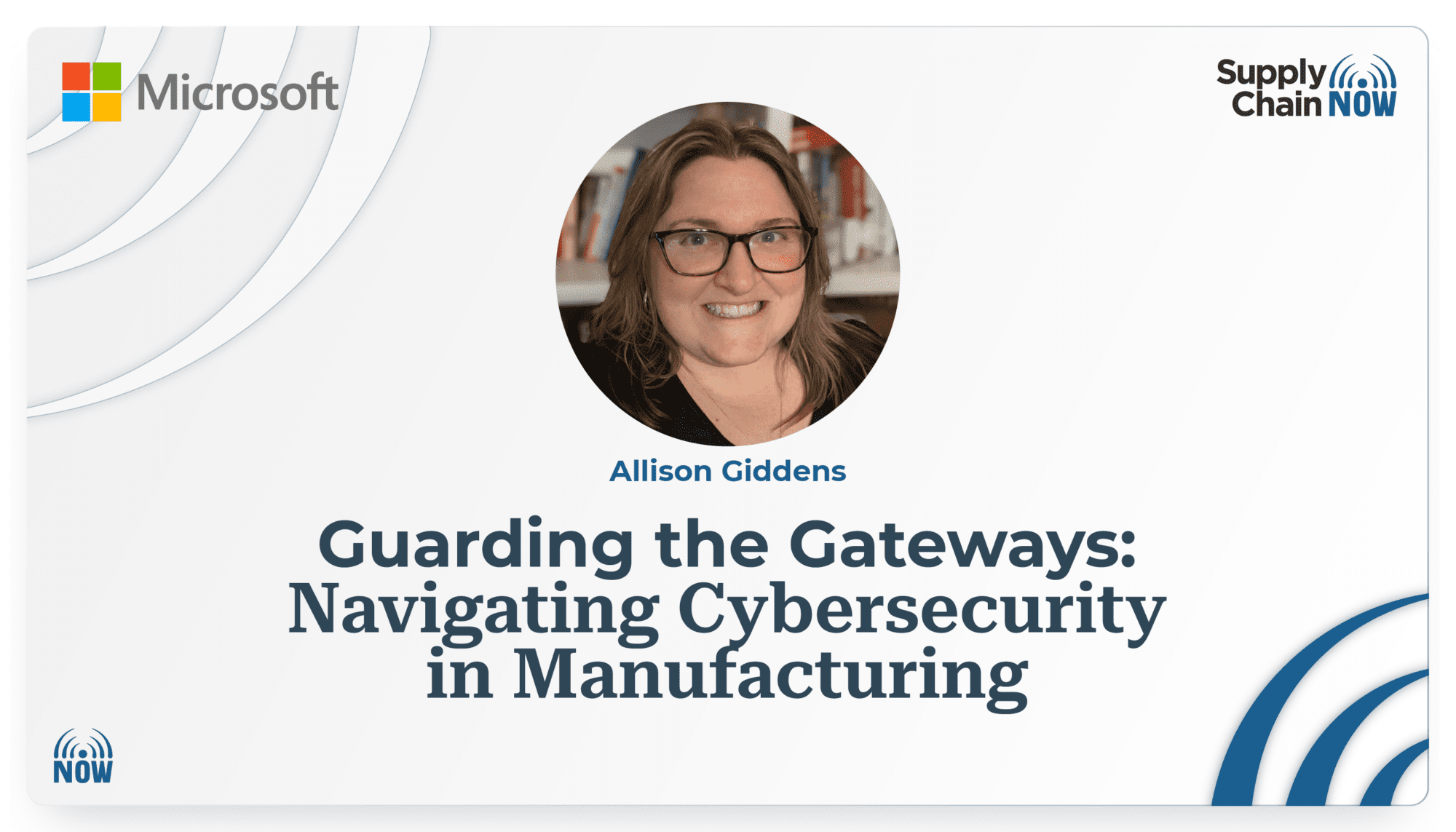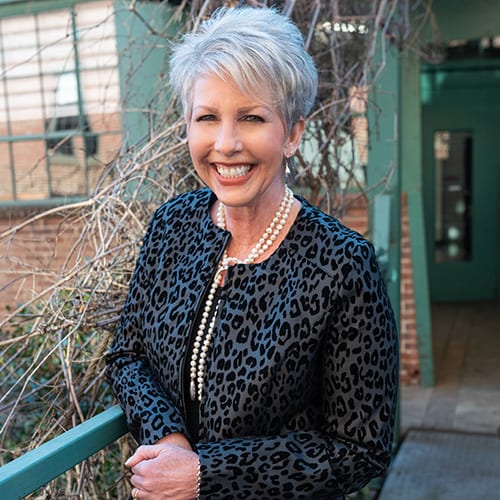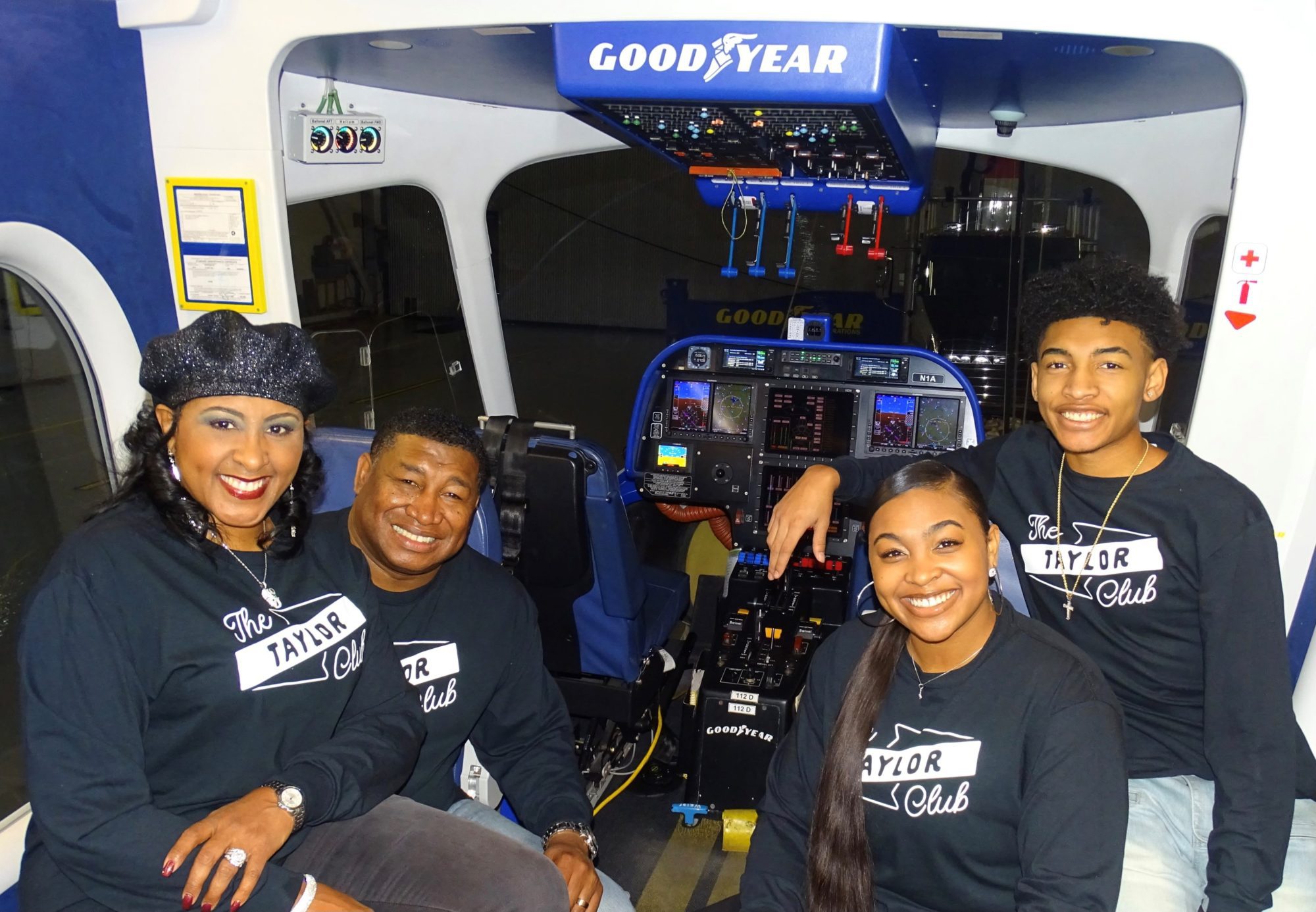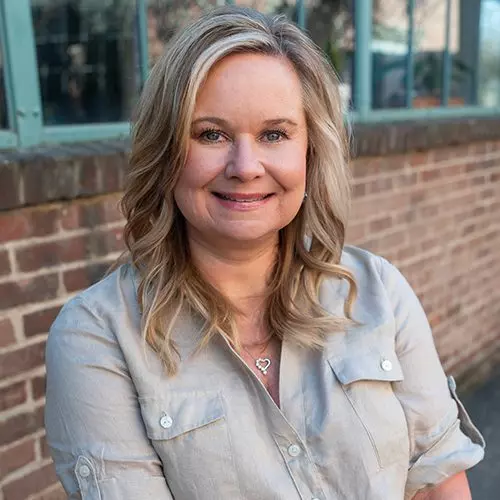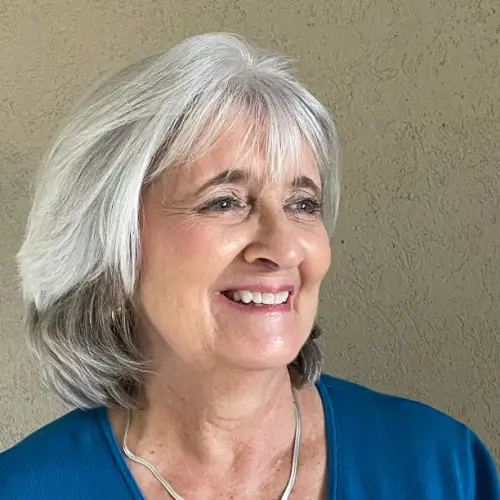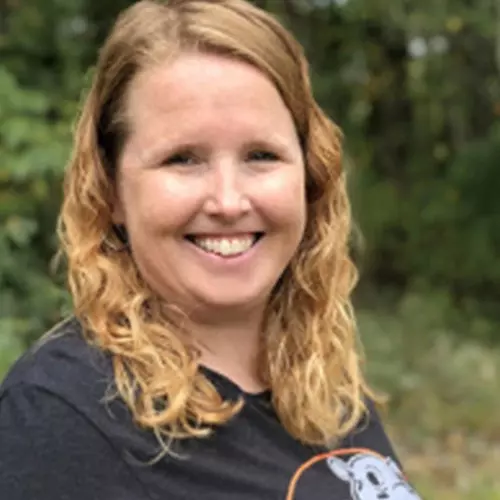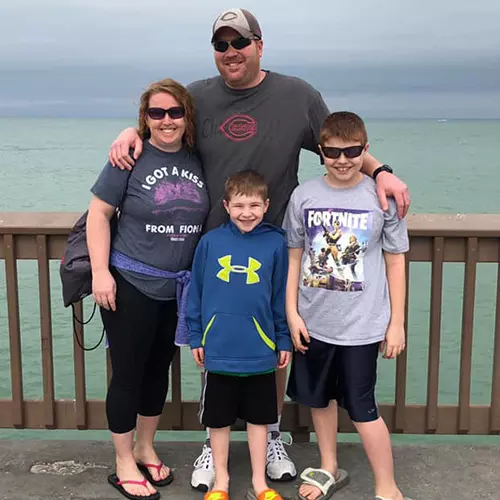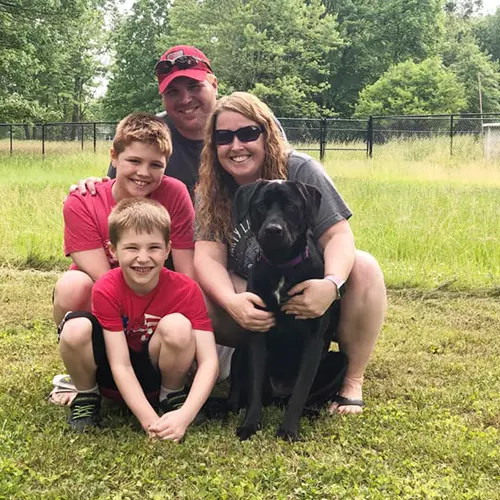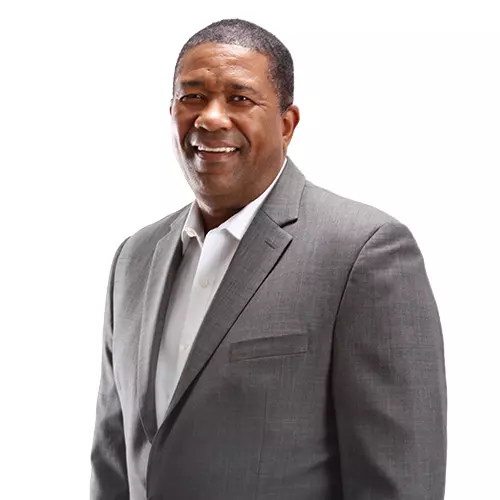Intro/Outro (00:03):
Welcome to Supply Chain Now, the voice of global supply chain. Supply Chain Now focuses on the best in the business for our worldwide audience, the people, the technologies, the best practices, and today’s critical issues, the challenges and opportunities. Stay tuned to hear from those making global business happen right here on Supply Chain Now.
Scott Luton (00:32):
Hey, good morning, good afternoon, good evening, wherever you may be. Scott Luton and Kevin L. Jackson with you here on Supply Chain Now. Welcome to today’s show. Kevin, how you doing today?
Kevin L. Jackson (00:41):
Hey, I am doing great. I mean, this is — I’ve had the Microsoft show. I tell you, I learned so much during these shows.
Scott Luton (00:49):
We’ve had some great conversations, and today we’re going to continue that standard of excellence here. So, outstanding show teed up today. We’re going to be diving into the hot topic, Kevin, of cybersecurity, especially from a manufacturing perspective. We’ve got a manufacturing leader here with us that spent years in the industry making it happen, no pun intended. And she’s going to share some critical considerations and perspective and expertise with this here today. So, folks, stay tuned for an informative, enlightening, entertaining conversation. Kevin, wouldn’t you think?
Kevin L. Jackson (01:19):
You know what? I was into this show from the very beginning. I saw all these planes flying over our guest’s head. You know me, planes.
Scott Luton (01:33):
I do, I do. And we love your stories as well. All right. Well, for some of our listeners out there that may not know, Kevin L. Jackson is a former naval aviator whose call sign was blazing. He’s got some great stories we’re going to have to revisit later on. We’re both big aviation nerds. He just has all the skillsets to make it happen. But I digress. Hey, today’s episode is presented in partnership with our friends at Microsoft who’s doing some really cool things in industry, helping to move us all forward successfully. More on that a bit later. But in the meantime, we’ve got a great friend of the show, outstanding guest here today. We’ll be featuring our guest who’s spent almost 20 years in the manufacturing industry and serving in leadership throughout manufacturing related initiatives. She’s become quite a voice for the industry, I would say. She currently serves as co-president at Win-Tech, a veteran-owned, woman-owned small business manufacturer, specializing in aerospace precision machine parts. Now outside of the workplace, our guest spends a ton of time giving forward and helping others, including helping to lead the nonprofit Dave Krache Foundation, which helps kids in need, play in their local sports leagues. We’re pleased to welcome a repeat guest and great friend of the show, Allison Giddens, co-president with Win-Tech, Inc. Allison, how you doing?
Allison Giddens (02:46):
I’m good. I’m good. How are you?
Scott Luton (02:48):
I am wonderful. Now, Kevin just picked right back up on your background and a lot of what y’all specialize in, all those cool aircraft. Kevin, which one stood out the most to you? Because I failed this test last time Allison was with us.
Kevin L. Jackson (03:01):
Well, all of them because they’re all Air Force airplanes. What’s the problem here? What’s the problem here? That’s the problem. You don’t like the Navy or something, Allison? What’s that? F15, the C-130.
Scott Luton (03:19):
All right. So a little give and take, folks. Yes. So Kevin was Navy, I was Air Force, I was a data analyst. He was a rock and roll pilot, Allison. He’s the cool one here. We’ve established that.
Allison Giddens (03:31):
Well, my uncle flew F-14s.
Scott Luton (03:33):
Really?
Kevin L. Jackson (03:33):
All right.
Allison Giddens (03:35):
I need an F-14 behind me, but I got —
Kevin L. Jackson (03:36):
That’s what I’m talking about.
Allison Giddens (03:38):
Yeah, yeah.
Scott Luton (03:39):
Man.
Allison Giddens (03:39):
Behind me, I have F-22, F-35, and C-130.
Scott Luton (03:42):
Okay.
Kevin L. Jackson (03:42):
Well, the F-35 —
Scott Luton (03:43):
Love those aircraft.
Kevin L. Jackson (03:44):
[Inaudible]. They do have a naval burn.
Scott Luton (03:50):
Half and half. They have a dual roll. They have a triple roll. They have all kinds of rolls these days, I’ll tell you. But we’re going to have to bring your uncle on later and get his F-14 Tomcat stories, Allison. But hey, nevertheless, we’ve got a lot to get into here today. And I want to start – Kevin, we were talking about this pre-show a little bit – some of the interesting chapters of Allison’s journey, and one of them is some folks may not know that Allison dabbled with standup comedy and actually performed at the venerable Punchline Comedy Club in Atlanta. So, Allison, what is one thing that standup taught you about business or leadership?
Allison Giddens (04:25):
Let’s see. One thing that it taught me about business or leadership, how to be flexible, how to think on your feet and be ready. I mean, if there’s a heckler, you got to be ready for that, right? But just in general, being able to play to the audience, that’s always important.
Scott Luton (04:40):
I love that. The power of spontaneity, Kevin, huh?
Allison Giddens (04:43):
Yes.
Kevin L. Jackson (04:44):
Actually, comedy is a great tool, especially as a leader, because you have to understand how to make people at ease, and jokes do that.
Scott Luton (04:55):
Well said Kevin. I love that. I’ve heard a former colleague used to tell me, when you hear people laughing in different parts of an office or a plant or a site or something, that means they’re enjoying each other’s time. Usually it means good things are happening. And to your point, because every day is not easy, how we can break the ice and lower the pressure with some comedy. I love that, Allison and Kevin. All right. So, kidding aside, Allison, one of the things we’ve talked lots of times in previous conversations about is your passion for addressing workforce challenges out in industry. So what is one thing, given all your time in the manufacturing industry, what’s one thing you wish more folks knew about the manufacturing workforce here in the States?
Allison Giddens (05:31):
Oh, gosh. In general, the workforce industry, I think it’s coming back. I think people are finally starting to understand that it’s important to learn how to work with your hands. And it’s important to look at a lot of these high-demand career initiatives. And I think that overall we can get our schools and our administrators back on board with bringing things back like shop class into high schools. I think that would do incredible wonders for the manufacturing industry.
Scott Luton (05:56):
Hey, Kevin, I love that. Allison says the manufacturing workforce is coming back. Your thoughts?
Kevin L. Jackson (06:01):
Yeah. No, actually, I think it’s really important because we’re losing that ability to link the work in the physical world, work with our hands, because everybody thinks that digital is going to replace physical, but it’s really important to understand how you can manipulate things to create what you need to do. And to date, technology is becoming a huge part of that as we leverage visualization to teach and learn how to build things better and faster, and shop is really where you can blend that physical and virtual world to get something much better.
Scott Luton (06:44):
Well said. I love that. And since Allison and Kevin both mentioned shop classes, there’s lots of other trades and I’m sure classes we want to get into schools, but shop class is a special one because so many folks can relate to it. I can give a shout out, rest in peace to Mr. Felton who taught me shop class in I think sixth or seventh grade at Schofield Middle School. And I got to tell you, it’s amazing to see what masters like that can do with wood. And if y’all hadn’t noticed, Allison and Kevin, woodworking, talking about hobbies that are coming back, folks are making stuff in their spare time all the time. So anyway, great call out.
Kevin L. Jackson (07:15):
That hand-eye coordination.
Scott Luton (07:17):
I don’t give it a — hey, I don’t have it. I don’t try my hand at it. But anyway, Allison and Kevin — Allison, thanks for sharing a few nuggets there about your background there. So tell us as we’re setting the table for our conversation, more focused on intersection of cyber manufacturing, tell us briefly about Win-Tech, Inc.
Allison Giddens (07:33):
So, Win-Tech, Inc. is an aerospace manufacturer. We are a small business, 22,000 square foot facility. We have a lot of CNC machines, a lot of mills, manual mills, manual blades, fabrication equipment, welding, waterjet, EDM, you name it, lots of different turnkey solution essentially for products that need to get manufactured for the industrial base and for the defense sector.
Scott Luton (07:58):
Love that and love the fact that y’all open up your facility for tours from students to other folks from across industry. Kevin, next time you’re in Atlanta, me and you’re going to go check out Win-Tech, Inc. How’s that sound?
Allison Giddens (08:09):
There you go.
Kevin L. Jackson (08:10):
I’m looking forward to it. But it makes me wonder how is that with the kids? You’re talking about bringing kids to see and learn. Do you get a lot of that? A lot of interest?
Allison Giddens (08:21):
Yeah. Well, we do a Manufacturing Day. Manufacturing Day is the first Friday of October every year. That’s a few years old, that initiative. And we open our doors to middle schools and high school students and we used to have upwards of 200 plus kids come through here every day, or I’m sorry, every Manufacturing Day.
Scott Luton (08:38):
Probably say [inaudible] —
Allison Giddens (08:39):
[Inaudible] every day. Oh, man, shoot me now. No, no, that would wonderful — that would be a wonderful thing. Right. No, but it’s an exhausting day. I will tell you that. I tell you that middle schoolers typically have the best questions and they’re the most engaged. High school students, most of them come through because it’s a day not in the classroom, but they’re still too cool for school. They don’t have too many questions, but every once in a while you get one kid that kind of sticks out, you’re like, alright, he or she, they’re going to do something.
Kevin L. Jackson (09:13):
Bring them back, right?
Allison Giddens (09:15):
Yeah, right. Hire them.
Scott Luton (09:16):
Allison, I love so much about what y’all do because we need more manufacturers that can do that as well, support Manufacturing Day, or just create those days where you engage the local student population and bring them in and help to battle some of the conceptions, misconceptions folks have about the manufacturing industry. So, Kevin, you and I are headed to Win-Tech, Inc. up in Kennesaw, Georgia, right, Allison? Next time you come —
Allison Giddens (09:39):
Yes, you got it.
Scott Luton (09:40):
To Metro ATL.
Allison Giddens (09:40):
Come on over. Give me a couple days heads up so I can make sure I’m here for you.
Scott Luton (09:44):
Awesome.
Allison Giddens (09:45):
And yeah, let’s do it.
Scott Luton (09:46):
Okay. I hate to move from that really positive note to a scary one because as we dive into our core topic of that critical intersection between cybersecurity and manufacturing, first we got to scare the heck out of everybody. So get this, folks, you don’t have to go far for unfortunately some bad news out there. According to cybersecurity ventures, cybercrime costs globally in 2023. We’re a staggering 8 trillion bucks. Holy cow. And it’s expected to rise to 10.5 trillion by 2025. So, folks, you know I like to talk about good news out there, but we got to keep it real. The challenge is only going to get tougher. So this conversation here and many others are really incredibly relevant. So, the good news, Kevin, is we’ve got a pro right here, especially between the two of y’all, between Allison’s work and manufacturing, as we said for years. And, Kevin, your work in all things technology including cyber and cloud. I’m really looking forward to this conversation here. But, Kevin, before I get to my first question for Allison, this should be a pretty cool and unique one-two punch, huh?
Kevin L. Jackson (10:45):
Yeah, absolutely, especially because of the importance of SCADA systems or supervisory or data acquisition systems. I mean, we’ve been in a transition where these electronic systems weren’t on the internet and now they’re jumping on the network, like everything is now on the network and these original systems weren’t designed to be on the network and they are the tools for monitoring these systems. So, talk about scary.
Scott Luton (11:16):
Yeah. And you got to take the good with the bad; you get cutting edge technology, innovative tools and platforms and whatnot. You got to come with some of the negative stuff that comes with that. But that’s okay because the good news is there are some excellent thought leadership here and lots of tools out there that we can get our cake and eat it too. So, Allison, getting into our first topic here today, there’s two — when it comes to cyber in the manufacturing industry, I like these two overarching considerations that you’ve shared with us and that we want to share with our listeners here. So, what are those two things for starters, Allison?
Allison Giddens (11:48):
I think the first two things that really come to mind when you start approaching the subject of cybersecurity and manufacturing is we talk a lot about, I think to Kevin’s point, about machines on the shop floor and connecting to networks. But I almost cringe when I hear that because a lot of manufacturers, that’s not where they need to start. A lot of manufacturers need to start with their computers in the front office, period, full stop. Yes, some equipment and some machines in a small business manufacturer may be on the network, but it’s not really that likely for, at least from my experience because for a couple reasons. One being our networks and our infrastructure are not mature enough. Many of the machines, even some of the newer CNCs, so those are computer numerical control machines, even some of the newer ones are still run using RS 232 cables, using kind of a centralized workstation on the shop floor to send data back and forth.
Allison Giddens (12:41):
So, while working on the security aspect of computers and workstations and technology on the shop floor is very important, I almost feel like we’re telling manufacturers, “Hey, you need to know how to run a marathon,” and they don’t even know how to walk a 5K. So, we need to back it up and we need to explain that they’ve got to have their IT in full force in security front of mind before they really start stressing about the OT. Because if their IT is appropriately in place, then their OT should be much more streamlined and able to control. Case in point, that most manufacturers, small business manufacturers, where is their risk? It’s not on whether or not the bad guys are going to hack a CNC. The majority of their risk is whether Julie in accounting is accidentally going to hit a link that says to download something for an invoice, and it turns out it’s phishing or it’s something scary and ransomware. I mean, you just look at Colonial Pipeline. How did they get in? They got through the financial system, they got through their accounting. So I think that’s really the key here is your people are your first line of defense.
Kevin L. Jackson (13:47):
Yeah. What I hear there is basic cyber hygiene that you have to focus on because that’s like the soft underbelly of any organization. Is that true?
Allison Giddens (13:59):
Bingo. Yep. It’s multi-factor authentication. It’s using MFA any place you get. Because anytime you hear — I want to say it was Microsoft that came out with some statistics not too long ago that suggested that nearly 99% of all incidents are all ransomware attacks could have been prevented using MFA. I mean, that’s such an easy implementation – I say easy implementation – but for a lot of people who aren’t using it, they have this notion that, oh, my gosh, I don’t want to spend more time logging into something. Come on, come on.
Scott Luton (14:30):
Hey, the risks are massive and they’re very real.
Allison Giddens (14:33):
Yes.
Scott Luton (14:34):
I want to pick up really quick on that last point you mentioned about the big point, people. It’s interesting that it’s the human factor, that’s our first line of defense when it comes to bad cyber actors, right?
Kevin L. Jackson (14:47):
Yeah.
Scott Luton (14:48):
So, I think it’s an important takeaway for folks listening to this. Business leaders, no matter where you are in your journey, is as important as the technology solution is to addressing cyber risk. What Allison and Kevin and both are saying, we got to spend time and invest in our people and make sure they’re up to speed on all the different risks out there. Allison, I know you and Kevin, I’ve gotten so many scary emails that you’re so close, it looks so real and you’re so close to clicking the link. Man, you’re down the rabbit hole, so spending time on awareness. Kevin, address that if you would really quick before I move on.
Kevin L. Jackson (15:20):
Well, one of the things that comes to me, it sounds like a tale of two shop floors. You have some of the larger companies that actually have an IT organization where their job is to understand the network and protect the network and provide training. But on the other side, you have the smaller businesses where the IT team is that corner of the CEO’s brain that they do IT with right next to the corner of the brain where they do accounts payable. It’s only when I have to do it and when there’s a problem. I was wondering how does Allison see this. Is that true?
Allison Giddens (16:07):
Well, I think a lot of small businesses have outsourced things that are not among their core competencies. So, for example, small businesses will often outsource their accounting. I mean, there might be somebody internal that prints checks and signs them, but there’s someone else that reconciles accounts or looks at the bank statements and things like that. So, similarly they’re doing that for IT. I know Win-Tech, we outsource our IT security. So, we have a full-time, 24/7, someone sitting there looking at our network. And that’s vital in an aerospace machine shop. And not everybody has that luxury and not everybody has those dollars to be able to spend. I mean, it’s not cheap. You have to work that into your cost back to your customer. But yeah, to your point, I mean the medium or bigger shops, they have resources for these kinds of things, and when it comes time to looking on their shop floor, they’re able to integrate systems a lot more methodically and intentionally. Whereas small businesses, especially small business machine shops, things are kind of band-aid on top of band-aids on top of, you know, this went down, okay, we’re going to replace this computer. All right, this happened. Well, we’re going to unplug it and leave the hardware, just plug something new in.
Scott Luton (17:15):
Bootstrapping.
Allison Giddens (17:16):
Right?
Kevin L. Jackson (17:16):
Yeah, that sort of sounds like another problem. Just like many industries, it’s about your ecosystem, it’s about the partners that you work with. So, cybersecurity in your organization is one thing, but you actually need to understand and be visible and aware of the cybersecurity with your partner that you work with that you depend upon.
Scott Luton (17:41):
Excellent point.
Allison Giddens (17:42):
Yeah, and you also in the midst of all of that, even if you outsource it, you have to understand it just enough.
Scott Luton (17:48):
All right. So, I got to go back, Allison and Kevin, to something that — Kevin, you said this, a tale of two shop floors. I wonder if that was Charles Dickens’ cousin, Tony Dickens that wrote that book.
Kevin L. Jackson (17:59):
Yeah, right, exactly.
Scott Luton (18:00):
I don’t know. All right. So, Allison, good stuff already as we knew we were getting, and I loved your earlier comment too. If you don’t know how to do a 5K, you got no business jumping right into a marathon. So, sometimes it’s good to think linear about these things, especially when we talk about these holistic approaches to mitigating the risks that are out there. So, I want to move into conversation about the cloud because goodness gracious, it offers so much to all global businesses out there and everything’s been moving to the cloud. But, Allison, what’s a few considerations from your perspective, especially from a manufacturing environment?
Allison Giddens (18:34):
So, manufacturing environment, there’s good and bad things about. There’s pros and cons like anything else. Pros to cloud are that you’re not having to invest a lot of money into new hardware every time something the latest and greatest comes along. The other pros are all about backups and the ability to back up data almost nearly in real time, if not in real time. Data storage these days in cloud is very cheap. It’s not like it used to be. Even a couple of years ago, I mean storage is a heck of a lot cheaper. You can just look at things like different cloud-based services, whether it’s Microsoft OneDrive or Google Drive or whatever your costs to back up things beyond their free, amount your terabyte of data or whatever. It’s crazy cheap. Those are all good things.
Allison Giddens (19:20):
There are still some cons though to consider, and I think these are elevated or perhaps highlighted in a small business. But in a cloud when you’re operating and you have all of your data in a cloud and that’s where it lives, you’re not just using it for backups. You have to consider the fact that as long as your Internet’s working, you’re working. But the moment that your internet goes down, now you might be a little hamstrung there to access your data. Additionally, if you are a small business and if you ever have a billing dispute with said cloud company, you’re at risk of now that data gets held hostage until you pay a bill. Not to say you should ever stiff anyone, but just giving you some ideas on the lack of leverage that I think some small businesses feel like they have. So, there are some things to think about along the way. Even if you are heavily invested in cloud and all of your network, your full network is in cloud, you should still consider diversification within the cloud. And you should still consider, all right, if my information lives in such and such company’s cloud, then I need to make sure that my backups live in somebody else’s cloud.
Allison Giddens (20:25):
And that’s just good business practice. That’s just God forbid something happened, and your main data not be available to you, now at least your backup data is. Of course, there are a lot of other implications to consider, compliance regulations. I deal with aerospace and export control data. So, all of my data can only be in what they call FedRAMP authorized or equivalent clouds. So that means basically cybersecurity on steroids. It’s just the easiest way to put it, but it’s also where you can only guarantee that U.S. persons access data rather than some sort of tech support in a country around the world that may or may not have some reciprocal agreements with the U.S.
Scott Luton (21:04):
Because life and death is at stake, right? If you’re making parts for aerospace and national security perhaps. So we got a particular platform. Allison, I think you’re going to just touch on it in a minute that probably is connected to that export control you were just referencing. But before you do that, Kevin, as someone that’s experienced, has written the book on cloud computing, I think, man, Allison’s speaking a lot of truth there. So, Kevin, your thoughts when it comes to what we got to consider with cloud computing?
Kevin L. Jackson (21:28):
Cloud computing, there’s always this debate between what you keep in the cloud and what you really must keep on premise. And it’s always raging in the manufacturing community and especially when you’re talking about protected data, ITAR data, or I’ve done quite a few FedRAMP implementations and also PII, and this even comes to play if you have individuals that work in your company that may be citizens of other countries where controls like GDPR may apply. So, I was wondering how do you address these things as a medium-sized business or a small business? Is there really the answer to what’s best on-prem or off-prem?
Allison Giddens (22:24):
So, for us there is. I think it’s the answer of what’s best. There is no answer. It’s always what’s best for the company. So, for us, what works for us is we are in Microsoft’s GCC High Cloud and that is an ITAR compliant cloud. So, we have our file server data just about — I would probably say 90% of our day-to-day lives in cloud. Our piece that does not live in cloud, that is on premise, it’s kind of a by design thing that we stay on premise. And I’ll tell you why. Our ERP, which is our enterprise resource planning tool, which essentially allows us to plan our jobs out from start to finish from sawing material to putting it on a machine to quality control from start to finish. We’ve had the same ERP for probably 25 years. I don’t love it, but it is what it is.
Scott Luton (23:15):
Well, I should just say, Allison, many business leaders would say that same statement out there.
Allison Giddens (23:19):
Got it. You got it. I don’t love it. I did love it at one point, I don’t love it anymore. But we were considering putting it in the cloud or migrating it to the cloud. We contacted ERP. They said, yep, we can do that. We got our IT. Everybody was good to go. We hit the button and then somebody on the other end of the line said, “Oh, you need a terminal server for this. But since you’re nowhere near the actual location of the terminal server, you’re probably going to experience some serious delays.” And we went timeout. So, long of the short of it is that our ERP remains on premise. So we have — it’s readily available. We handle backups both on premise and in the cloud. So it’s really, when it comes to whether you’re small, medium, large manufacturer, whether or not you’re solely in the cloud, you have to consider your business processes. You have to consider obviously cost, but you also have to consider your compliance requirements. Like you said, Kevin, whether it’s ITAR, whether it’s GDPR, whatever you’re having to do, PII, all that stuff, whatever compliance that you’re telling your customers that you can check the box, you need to make sure you can actually check the box.
Kevin L. Jackson (24:28):
Yeah. So that’s really important. And everybody knows I’m a cloud guy. But the thing that I cringe is these organizations that, quote, discover the cloud and initiate a cloud first policy and they don’t go through the thought process of evaluating their business processes and the data associated with those processes to make a conscious decision of where that data can go either on-prem or off-premises in the cloud. I really appreciate your answer there, Allison.
Scott Luton (25:05):
Yeah.
Allison Giddens (25:06):
I think that there’s also something important that people need to remember. There’s a notion that if we go to the cloud that easy and we can set the crock pot and forget it, come back eight hours later. Right?
Scott Luton (25:17):
Easy pot these days, easy pot.
Allison Giddens (25:19):
And you’re right. Right. But I think that it’s important to think of, there’s still due diligence that a manufacturer has to do, and companies like Microsoft, other companies as well, they have shared matrix responsibilities or customer responsibility matrix shows shared responsibilities, and these are very clear documents that says, yes, if you implement our solution, here’s what we’re going to do and here’s what you’re going to still have to do. And there’s very clear instructions and I think that’s very important and kind helps us get out of that notion that, oh, well, gosh, if I hand over to so and so, they’re going to take care of this for me.
Scott Luton (25:52):
Right.
Kevin L. Jackson (25:52):
Oh, yeah, absolutely. Cloud service provider is not just a vendor. They’re really a partner and we’re talking about cloud security and there’s that shared security model that you really have to put in place religiously with all your cloud service provider.
Scott Luton (26:12):
Right. Well said. All right. Allison, you touched on ERP there, and one of the things we want to ask you about is ERP, CRM, all the acronyms, right? All the different tech and the platforms and the apps, you name it. I mean, billions and billions out there it seems and growing, right, as we continue to move at a greater velocity in an ever more changing and technological environment. It’s really — it’s a fascinating time to be in global manufacturing, global supply chain, you name it, global technology. Anything else you want to add? You shared taking that deliberate approach to what’s right for your business. One of the things you kind of spiked the football on a second ago, doing that due diligence, especially when it comes to ERP or any of this stuff. Anything else you want to add to what comes into play for manufacturers like yourself when you’re selecting the right apps and tech to use?
Allison Giddens (27:00):
I think that layering applications at tools and different software onto a network with security in mind, it can be very challenging. And it seems a lot easier if you’re starting from scratch. If you’re like, okay, I’m going to start a company. I’m going to use this tool for this and this tool for this. It’s clean, but that’s not natural. That’s typically not really what happens. You’re in a business and you’re told, by the way, this is the latest thing to worry about. Okay, gosh, now I got to go through my business processes and make sure that I’m not doing X, Y, Z. There are tools out there. There’s a NIST cybersecurity framework. CSF just released 2.0; they’re newest, latest, and greatest. And it’s very basic steps and ideas, but it is truly a framework, a good base to start with, whether you’re a manufacturer or any other company. And that starts with identification of what you have to begin with. That’s the identification of your assets, your hardware, your software, ultimately your information, like your data flow in general, like what makes your business tick when it comes to ERP, CRMs, your applications, whether I have GCC High or whether I have Office 365. All of these things are identifiable and we need to put them on paper as manufacturers because when we understand what we have, then we can understand how to protect.
Scott Luton (28:15):
Yeah, well said. I love that. And I look back to identification. So, Kevin, some of you aviators out there identifying who’s a friend, who’s a foe. There’s a business application right here. Your thoughts, Kevin?
Kevin L. Jackson (28:29):
Well, one of the most important things for any organization, I think I alluded to it before, is knowing your data because that’s how you determine your needs with respect to your infrastructure and what a manufacturer, especially if you have a broad set of products or customers or even locations where you operate, it’s all about the data. So that’s critical.
Scott Luton (28:57):
That’s an excellent point. And you were on an event earlier today and you quoted someone, it’s very relevant here because everything produces data and all data is important. But the central core data is the business and is everything right. And we got to protect the data supply chain, so to speak, and the data highways and byways so it stays in the right hands and it doesn’t become tainted by bad actors out there. Kevin, I’m butchering this analogy. You said it so much more eloquently earlier, but if you would quick comment on that.
Kevin L. Jackson (29:32):
Yeah, yeah. We were talking about digital currency in that conversation, and I wanted to make the point that the most important digital currency is digital data. And it’s not Bitcoin, it’s not Ethereum. It’s not the digital securities that you’re putting in your 401(k). It’s your data. It’s your data. So, any business really needs to trust that data as their most important digital asset or their most important asset, period.
Scott Luton (30:06):
Yeah, well said. Truly, regardless of what industry you’re in, I like what you say there. It’s a lifeblood in the business. I mean, it’s how decisions get made. It’s how bets get made, and every business has got to make bets on —
Kevin L. Jackson (30:17):
You got to make bets.
Scott Luton (30:17):
What’s going to be taking place, right?
Kevin L. Jackson (30:19):
Yeah.
Scott Luton (30:19):
So, good stuff there. All right. So, Allison, I’m going to get into the last couple of questions we got for you. We can’t have a conversation these days without mentioning artificial intelligence. And I’m kind of tongue in cheek there because for good reason, right? Because the outcomes we’re seeing, it’s really the golden age of AI, the outcomes we’re seeing across global business is why we’re talking so much about it, right? Kevin, I think you also said – see, I was taking notes earlier today. I think you also said great ideas have lots of friends. Because once folks start seeing outcomes from new and old technology or new and old approaches or processes, you name it, you’re going to get the grass is greener and you’re going to get stops and stairs and folks are going to figure out, hey, how can I use that? So, Allison, what a long setup for this question, but how do you see AI factoring into cybersecurity, especially in manufacturing environments?
Allison Giddens (31:10):
Gosh, that’s a loaded question. How long we got for this episode?
Scott Luton (31:13):
I know. No kidding.
Allison Giddens (31:15):
So I think that there are a few different considerations to make when you’re thinking AI and cybersecurity in manufacturing. It’s not only the scary part; it’s not only the bad guys using AI to effectively develop the next big bad thing, but it’s also, I think, feeds into insider threats, unknowingly, unwitting insider threats. So I’ll give you an example. In my industry, there’s something called confidential unclassified information, CUI, and it’s essentially government data or it’s data that the government has deemed not sensitive enough to mark as classified, but not exactly something we want the bad guys to have either. It’s essentially what that means. Well, if you’ve got manufacturers working to try to get efficient or trying to automate things, it can be tempting to feed data into something like a ChatGPT. Well, if you’re feeding CUI into an application such as ChatGPT, or really anything, a general open version of Microsoft Copilot or any kind of AI application, you run the risk of [inaudible] sharing data essentially. And so now the person that did that in your company, that is by definition an insider threat. A threat came from inside the company and something a spill might’ve happened. So these kinds of artificial intelligence things to consider is I think that we can use AI for good. And I think that, I mean, heck, almost every day I’m using it for something silly like, “Here, draft this email. I want to say this in a nice way, but I don’t want to be too nice.”
Allison Giddens (32:43):
So, that’s super helpful. But there’s also the considerations of it’s not just about the data that we’re using that’s coming out of AI from a cybersecurity perspective and keeping data secure. We need to watch what kind of data we are giving AI in the first place.
Scott Luton (33:01):
Yeah. Kevin, your thoughts there?
Kevin L. Jackson (33:03):
The line continually blurs between the good and the bad, what you should do, what you can’t do, the line between doing something at work and doing something for the rest of your life. It’s not there. And I think artificial intelligence makes it even more blurry. So that makes you need to think about all aspects of your life and how to interact [inaudible] and how you use these very powerful, very important tools. Don’t be afraid of AI. You just have to learn how to use it. Look at AI like it’s a chainsaw, very powerful, very useful, but it could cut your lens.
Scott Luton (33:47):
I’m not going to relay my stories, my mishaps with chainsaws. But, Kevin, I love that. I love the greater message there. You can’t be afraid of this technology. You got to take time. What Allison’s kind of talking about, explore and experimenting with it as you kind of figure out its place in the business, right?
Kevin L. Jackson (34:04):
Yeah.
Scott Luton (34:05):
And if you don’t do that, the threat is you fall behind.
Kevin L. Jackson (34:09):
You won’t be in business.
Scott Luton (34:11):
You won’t be in business. All right. So, thank you Allison for kind of weighing in there and I can’t wait to check out how you’re using ChatGPT next time we are together. I love that. Hey, help me make this a little bit softer, this message a little bit kinder. All right. So, moving right along. So, Allison, really have enjoyed your perspective on that critical intersection of one of our favorite industries ever, at least mine, in manufacturing and how it intersects with cyber and how we got to keep our finger on the pulse of a lot of cool things you’re doing as your business continues to grow and moves into the future. But I want to talk about kind of the past with that. And one of the things we’ve spoken about a lot here in previous conversations is your involvement, your leadership, your work, your elbow grease, you’ve put into an organization called Women in Manufacturing. In fact, as Kevin may recall, Allison helped establish the organization here in Georgia. So, Allison, in a nutshell, what is it? And then what’s been one of your coolest aspects related to your involvement in WIM?
Allison Giddens (35:07):
So yeah, it’s a great organization. They work to support and promote, inspire women in the industry. And, gosh, think of all the things I’ve done with WIM Georgia and they’ve got a great leadership team in place right now. I kind of took a few steps back to try to give some new people the opportunity to do good things. And that was a few years ago and they’ve just blown it out of the water. It’s been awesome.
Kevin L. Jackson (35:29):
Wow.
Allison Giddens (35:29):
But I think one of the really cool things that I did a few years ago was I toured the GE plant in Lafayette, Georgia, and then a few years later ended up buying a GE cafe range gas stove and learned that that stove was actually built at the plant that I toured.
Scott Luton (35:49):
I love that.
Allison Giddens (35:49):
So that was pretty cool.
Kevin L. Jackson (35:51):
Connections.
Scott Luton (35:54):
Yes. If more consumers had epiphanies and eureka moments like that, think of the awareness we would have, not just in manufacturing but supply chain and so much else. So, I love that story. And y’all check out Women in Manufacturing out there. They put on great local and events. I think probably coast to coast, maybe even internationally. But great work, Allison.
Allison Giddens (36:12):
They do. They have international chapters now. So check it out.
Scott Luton (36:15):
That is outstanding. Y’all Check it out, Women in Manufacturing. Kevin, speaking of cool things, maybe as cool as what Allison just described, tell us what Microsoft has been doing out there in the manufacturing world.
Kevin L. Jackson (36:28):
Well, we’ve been talking about cloud and the importance of cloud, but cloud computing really enables you to future proof your organization, your company, because you need to make sure that you can continue to create value and it also helps you develop and produce sustainable product to embrace those new designs and manufacturing paradigms that come out all the time. And this is a supply chain show. You need the cloud help you create more resilient supply chains, right, to ensure business continuity and to reduce risk with a secure and agile and connected supply chain and, what I like to say, this supply mesh. And as we move forward, you can’t not think about the intelligent factories that are in place today, the automation of manufacturing that ensures safe and reliable production and it really empowers your workforce. It makes the people better so they can focus on the things that people can do best. And in the end, it’s all about maintaining and enhancing the connection with your customers. You need to modernize that customer experience, increase satisfaction, and make sure that that product is continually scratching that itch, that changes. So cloud is a critical part of your present and your future and that’s what Microsoft is really focused on, especially in the manufacturing industry.
Scott Luton (38:13):
I love that. Poetic. We’re going to include a link in the show notes. Y’all can check out more about what Kevin’s sharing, what our friends at Microsoft are doing. Allison, I loved a couple things, just to cherry pick a couple things that Kevin just shared there, is making sure that the value creation is uninterruptible. I love that. And the other thing that Kevin alluded to, I don’t think he used this word, but one of my favorite recent words is frictionless, taking friction out of organizations and operations and business. And, Allison, I tell you, I don’t know about you, the world has too much friction. So, I’m trying to find ways of pulling it out of how we do business and how we work with others and how we create ecosystems that all parties can really succeed. Hey, I think a big part of the name of the game is taking friction out. Would you agree, Allison?
Allison Giddens (38:59):
Yes. Yeah, I think everybody wants things done easily and people want to take the path of least resistance, and if you make something difficult, people aren’t going to do it. And that’s the name of the game. It’s the way it’s always been.
Scott Luton (39:11):
That is right. Man, you’re so wise beyond your years, Allison. I love that. It’s timeless. It’s really a timeless truth what you just shared there. All right. So, Allison and Kevin, I’ve really enjoyed this conversation. Allison, thank you for bringing a truckload of brilliance when it comes to cyber, manufacturing and leadership here today. Between you and Kevin, as we mentioned, it was quite a one-two punch. So how can folks connect with you, Allison? Maybe they want to have you come in and give a keynote or just talk business with you or see what y’all are doing at Win-Tech, Inc. How can they connect with you?
Allison Giddens (39:40):
Definitely reach out on LinkedIn. If you want to connect with me, that’s great. I would encourage you to include a note when you connect only because I do not connect with everyone that asks. I need some context. Yeah, I get a lot of spam. I get a lot of spam.
Scott Luton (39:58):
Hey, so y’all listen, put that note in there.
Allison Giddens (40:00):
Frictionless y’all. Come on.
Scott Luton (40:02):
That’s right. You’ll be creating friction if you send a blank invite to Allison. Now, I love that.
Allison Giddens (40:08):
Ignore. I do not know this person.
Kevin L. Jackson (40:10):
Ignore.
Scott Luton (40:11):
Well, hey, Allison, I’m looking forward to y’all. I know you got a lot of upcoming programming you get out and speak and all. I really enjoy y’all sessions. So looking forward to that to come and thanks for being here, Allison Giddens with Win-Tech, Inc.
Allison Giddens (40:23):
Thanks for having me. Thanks.
Scott Luton (40:24):
But hey, before you leave and before we wrap up, Kevin, man, you’ve been on a tear. I’ve got several of your T-shirt-isms that I’m hanging up in the office now. It’s like you’ve been very Shakespearean here lately. And of course, Digital Transformers is on to the next big bright chapter. So how can folks connect with you and your popular series?
Kevin L. Jackson (40:44):
Well, first of all, yes, Digital Transformers is transforming.
Scott Luton (40:48):
Love it.
Kevin L. Jackson (40:48):
We’re looking to the future to understand how Web3, and Industry 4.0 is changing every industry vertical. And we’ve started this month with first edition of, I guess, Digital Transformers 2, where we were talking with Constellation Network on how the blockchain is really changing every industry vertical. So check out that energy that I had.
Scott Luton (41:20):
Awesome.
Kevin L. Jackson (41:21):
We’re going to have more coming in the near future. And the best way to catch up with me is on Digital Transformers here at Supply Chain Now. But I’m on LinkedIn too, so you can search with me there, or on the X, @Kevin_Jackson.
Scott Luton (41:39):
Hey, if you can’t find Allison Giddens or Kevin L. Jackson on LinkedIn, something’s wrong. Shoot me a note. We’ll send out a SWAT team, make sure they’re okay. Kidding aside, I love what you’ve got going on with DT 2.0. So, folks, find Digital Transformers with Kevin L. Jackson, wherever you get your podcast from. Okay, man, big thanks to Allison Giddens once again with Win-Tech, Inc. Big thanks to Kevin L. Jackson, love doing shows here with him. Big thanks to our collateral partners over at Microsoft as well, helping us to bring these inspiring stories and leaders like Allison to our global audience. So, to all of our listeners out there, the onus is now with you though. You got to take something, some of the brilliance that Allison and Kevin dropped here today. Just pick one thing, put it into action. I promise you your team will appreciate it. It’s all about deeds and not words. And with that said, on behalf of our team here at Supply Chain Now, Scott Luton challenging you to do good, to give forward, and to be the change. And we’ll see next time right back here at Supply Chain Now. Thanks, everybody.
Intro/Outro (42:34):
Thanks for being a part of our Supply Chain Now community. Check out all of our programming at supplychainnow.com and make sure you subscribe to Supply Chain Now anywhere you listen to podcasts. And follow us on Facebook, LinkedIn, Twitter, and Instagram. See you next time on Supply Chain Now.
